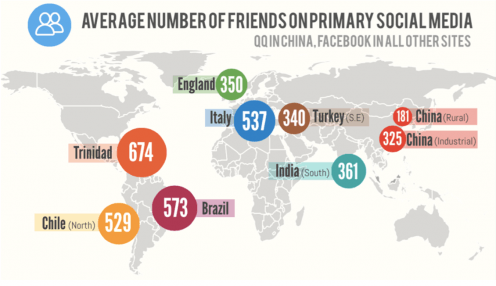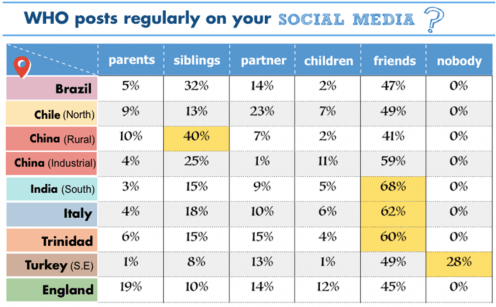Surveying Social Relationships
By Daniel Miller, on 2 October 2015
One of the chapters of our forthcoming book How the World Changed Social Media, which will be published as an Open Access book by UCL Press in February 2016, describes a survey consisting of 43 questions we asked 1199 respondents (mainly around 100 per fieldsite).
Just occasionally this survey produced results which were commensurate with our general ethnographic data, for example, this chart showing the average number of friends is well matched by what our informants say about how generally sociable they feel people are in the place where they live.
Similarly this figure of whether people use social media to develop new relationships makes sense to us. In some places such as Brazil or Trinidad it is because prior to social media people typically developed friendships through the mechanism of becoming friends with the friends of already established friends or relatives, and this is something that social media lends itself to. By contrast the issue in industrial China is that factory workers, who are constantly shifting from place to place, grow to rely on their online connections as the place for developing friendship, partly because opportunities are quite limited for friendship offline.
But in other cases the results of this survey are clearly incompatible with what we know from our ethnographies, and we will always favour the authority of 15 months living with a community over a mere survey. It will not be hard for you to spot the problem in the next figure. This is the high number of people in our rural Chinese site who mention siblings as the people who most often post on their walls. The problem is, of course, that given the one family per child policy, most of these young people don’t have siblings. McDonald suggests this is a combination of two factors. Firstly those who do have siblings perhaps share a very close relationship with them. But, this figure also represents a practice in China where it is common to refer to one’s cousins as siblings. It was just one of many examples where we found that our survey could be very misleading unless you had the ethnographic background to understand how and why people had interpreted our questions in a particular and often unpredicted way.
18 Responses to “Surveying Social Relationships”
- 1
-
2
DannyAnth wrote on 2 October 2015:
My latest blog post on the need for ethnographic background when interpreting surveys of relationships.
http://t.co/aFOgXtd3m3 -
3
koldobizkar wrote on 2 October 2015:
RT @DannyAnth: My latest blog post on the need for ethnographic background when interpreting surveys of relationships.
http://t.co/aFOgXtd… -
4
rumagin wrote on 2 October 2015:
RT @DannyAnth: My latest blog post on the need for ethnographic background when interpreting surveys of relationships.
http://t.co/aFOgXtd… -
5
haujournal wrote on 2 October 2015:
RT @UCLSocNet: Why you need ethnography to interpret a survey http://t.co/T6xqHBIJq6
-
6
Sindelo_ wrote on 2 October 2015:
RT @UCLSocNet: Why you need ethnography to interpret a survey http://t.co/T6xqHBIJq6
-
7
wokoban wrote on 4 October 2015:
Cool: Surveying global social relationships http://t.co/59OyPgByTe via @olga_kravets #mixedmethods #SocialMediaMarketing #crosscultural
- 8
- 9
-
10
UCLSocNet wrote on 5 October 2015:
#Surveys can only tell you so much. Here’s why you need #ethnography to interpret them http://t.co/XZrsgKPvjM
-
11
PeepsForum wrote on 5 October 2015:
On the importance of having the #ethnographic context when reading #surveys http://t.co/N4uWpHsfcF via @UCLSocNet #socialmedia
-
12
hichamchraibi wrote on 5 October 2015:
Why you need ethnography to interpret a survey. http://t.co/66PB2EpjtD #socialmedia
-
13
operanomad wrote on 5 October 2015:
RT @PeepsForum: On the importance of having the #ethnographic context when reading #surveys http://t.co/N4uWpHsfcF via @UCLSocNet #socialme…
-
14
Tacli wrote on 5 October 2015:
RT @UCLSocNet: #Surveys can only tell you so much. Here’s why you need #ethnography to interpret them http://t.co/XZrsgKPvjM
-
15
SMRSocial wrote on 6 October 2015:
RT @PeepsForum: On the importance of having the #ethnographic context when reading #surveys http://t.co/N4uWpHsfcF via @UCLSocNet #socialme…
-
16
profiballester wrote on 6 October 2015:
Surveying Social Relationships – Global Social Media Impact Study http://t.co/C7wQQRAmTs
-
17
UscPublicidad wrote on 6 October 2015:
Surveying Social Relationships – Global Social Media Impact Study http://t.co/c942H1uchV
-
18
IlianaBallester wrote on 6 October 2015:
Surveying Social Relationships – Global Social Media Impact Study http://t.co/Sdg25iMPLW
 Close
Close








RT @UCLSocNet: Why you need ethnography to interpret a survey http://t.co/T6xqHBIJq6